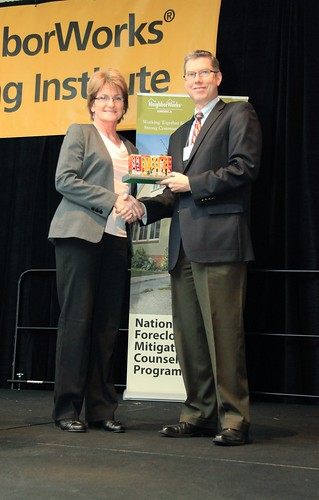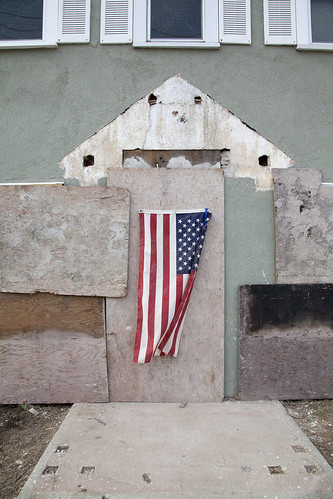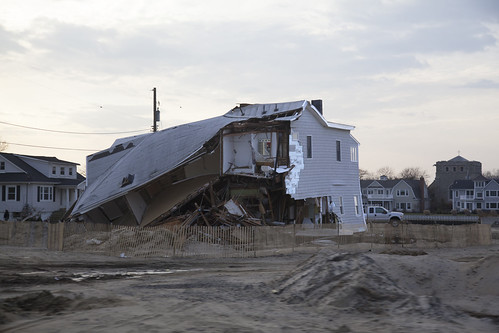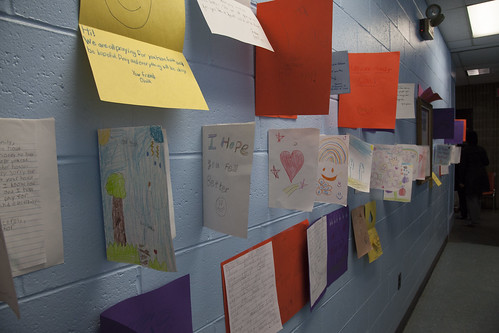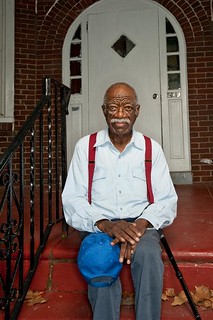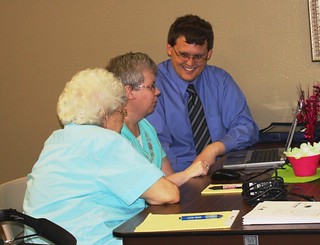This blog comes to us from Susan Jouard, Public Affairs and Communications Advisor for NeighborWorks America's Northeast Region.
NeighborWorks America Northeast Region held its seventh annual reception on November 29. This signature event brought leaders from throughout the housing and community development field together to honor “Visionary Leaders in Community Development” under the theme of “A Community United”.
 |
Tina Brooks, Eileen Fitzgerald, Alfred DelliBovi,
Denise Scott, Deborah Boatright, Rev. DeForest Soaries |
Over 200 people joined NeighborWorks CEO Eileen Fitzgerald and Regional Director Deborah Boatright as Alfred A. DelliBovi, president & CEO of Federal Home Loan Bank of New York and Denise Scott, managing director of LISC NYC were honored. Citi Community Development hosted the event at their mid-Manhattan headquarters.
Guests included representatives from 23 of the region’s NeighborWorks organizations, who view the annual reception as an invaluable opportunity to network with key partners, funders and colleagues. NeighborWorks’ national office was well-represented by Chuck Wehrwein, COO, Robert Burns, the outgoing director of Field Operations and who received a special recognition at the event, Paul Kealey, director of Training, Jayna Bower, director, NCHEC; Christine McHenry, director, Public Relations and the NeighborWorks development team: Jeanne Wardford, Akilah Watkins-Butler and Jennifer McAllister.
VIPs included two presidents from the NYS Department of Homes and Community Renewal, Mathew Nelson and Marian Zucker, Commissioner Mathew Wambua, NYC Dept. of Housing and Preservation, Marc Jahr, president & CEO, NYC Housing Development Corporation, Bob Annibale, global director, Citi Community Development, Pam Flaherty, president & CEO Citi Foundation, Michael Rubinger, CEO, LISC and Katheryn Wylde, president, Partnership for New York City. The region was especially pleased to welcome several guests from the Philadelphia area where the region has been doing extensive partnership work.
Super Storm Sandy was on many people’s mind, coming just a month before the reception.
“A lot of the conversations in the room are about the impact of the storm, and how we can support each other. Connections are being made, and new collaborations are taking shape,” said Boatright in her remarks. “I am so proud of all of us here—the non-profits, government, financial institutions, national intermediaries, funders and partners. Everyone is stepping up to help families rebuild and neighborhoods rebound.”
These sentiments were echoed by Eileen Fitzgerald: “NeighborWorks America is committed to working with our affiliates and partners to help in the Sandy recovery effort. Together, we will continue on the path to recovery in the next few weeks and months”.
But the evening belonged to the two widely admired visionary leaders in community development, Alfred DelliBovi and Denise Scott.
DelliBovi, who has served at the helm of the Federal Home Loan Bank of New York (FHLBNY) for 20 years, is a nationally recognized authority on banking, the lending industry, housing and public finance, and a champion of sustainable homeownership for low and moderate income families. In 2012, the bank awarded $70 million in grants to help build or preserve 5,500 affordable homes and 5,000 affordable rentals; and closed 680 loans for members of the First Home Loan Club.
DelliBovi was introduced by New Jersey’s the Reverend DeForest Soaries, Jr., a member of the FHLBNY’s board of directors and a close partner of NeighborWorks, who spoke about DelliBovi’s business acumen and deep sense of social justice.
In accepting the award, DelliBovi said: “It is more than an honor to work with NeighborWorks America and its leadership -- Deborah Boatright and Eileen Fitzgerald. Thank you for bestowing on me NeighorWorks’ Visionary Leader Award. I accept this award not as an individual, but as a member of the New York Home Loan Bank team. A team that works every day with our member community lenders to enhance the value of that fundamental element of our culture and society: the home.”
Denise Scott, managing director of LISC New York City, was celebrated as a “go-to” person whenever there is a new challenge facing New York’s neighborhoods. She successfully raises millions of dollars every year in equity and loan capital in support of affordable housing and community and economic development projects.
“One would be hard pressed to find a more, trusted, respected and beloved community developer in New York City than Denise Scott,” said Boatright.
Tina Brooks, executive vice president of LISC, was on hand to help present the award to Scott, talked about her exceptional ability to create private and public partnerships that is admired throughout LISC, and that has been a hallmark of her 30-year career in the field.
Guests lingered long after the two hour reception ended, with more than one guest noting how it always seemed too short because they were so many people to talk to– truly a hallmark of success!
“We started the reception with the goal of bringing the full spectrum of the housing and community development field closer together. Thanks to the generous support of our sponsors every year, there have been no barriers to attendance, and the focus has always been on the building of new relationships in a collegial atmosphere, and the honoring of our heroes,” said Boatright.
To view photos of the 7th Annual Northeast Region Reception,
visit our Flickr album at http://www.flickr.com/photos/neighborworksamerica/sets/72157632217019960/with/8260786729/.








